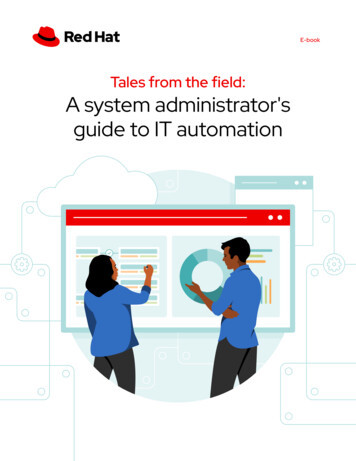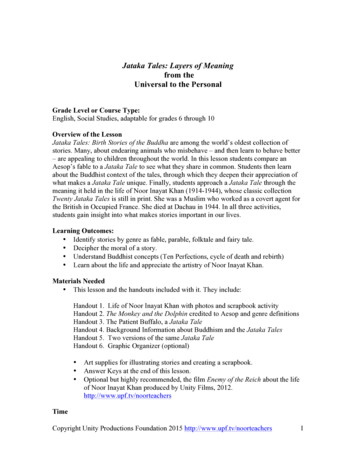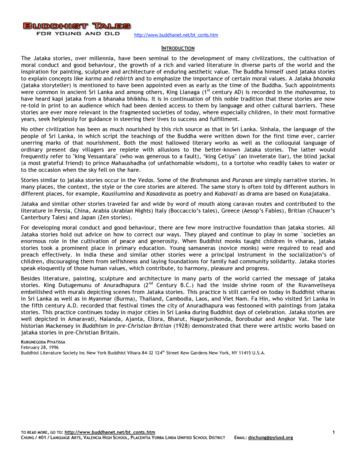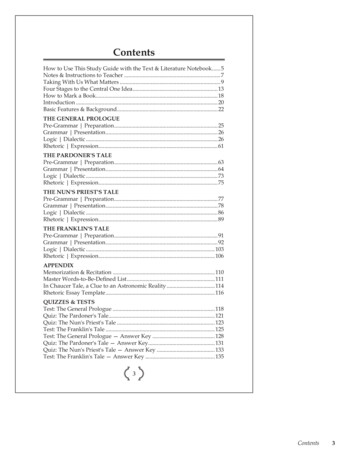
Transcription
E-bookTales from the field:A system administrator'sguide to IT automation
Tales from the field: A system administrator's guide to IT automation3Introduction4Chapter 1: Dispelling common IT automation myths145Why I was scared of IT automation84 IT automation myths dispelled11How to automate routine tasks to avoid mistakes—and save timeChapter 2: The benefits of IT automation15Numbers talk: Getting your team on board with IT automation18Use automation to combat your increased workloads21Take control of your operations: Forge a new way to work24 Case study: Saving time with IT automation27Chapter 3: How to become an IT automation expert28 The rise of the automation architect32 8 skills you need to be successful in IT automation37 6 ways to increase your Linux sysadmin earning profile and potential41445 ways to change your team to an automation-first mentalityClosing: How to get started with IT automation45 Embracing IT automation: Why it’s good for your career—and howyou can get started48 Get started2
IntroductionIntroductionBy Emma Van Sant, Senior Program Marketing Manager, Red HatWelcome to Tales from the field: A system administrator’s guide to IT automation. Thiscompilation of short stories seeks to share the excitement, frustrations, successes, andchallenges associated with incorporating IT automation into organizations and teams acrossthe globe.Few technologies impact organizational transformation the way that IT automation can.IT automation improves security and compliance, abstracts away complex tasks for thosewith limited technical knowledge, improves standardization across the organization, helpsorganizations scale, improves continuous delivery, and reduces operational complexity andcost. But when adopting a holistic IT automation adoption mindset and approach, thesebusiness benefits come with an equal number of challenges.At the most fundamental layer, automation is really about people. A popular phrasewithin our Red Hat team is “technology is easy, people are hard.” While this sentimentundoubtedly glosses over the technical difficulties associated with adopting a newtechnology, it’s clear that the phrase has merit. The results from a recent study indicatethat lack of training, fear of replacement, and organizational culture were all top barriersto widespread automation adoption. Six of the 10 barriers cited in the survey werepeople-culture oriented barriers, not technical ones.¹ People are the key to any successfultechnology implementation and adoption. Without buy-in, training, support, planning, andsecurity, any automation adoption initiative is set up for failure.This book is a compilation of stories about these very challenges, written by Red Hat authorswho have struggled with cultural, emotional, and practical barriers to holistic automationadoption within organizations. These writers have spent years either implementingautomation within their organizations, or decades consulting on the implementationand adoption within other teams. This book is a good starting point as you become yourorganization’s IT automation expert—and explore what that means for you and your career.Emma Van SantEmma is a Senior Program Marketing Manager focused on Global IT Automation at Red Hat.She’s spent the last seven years working in IT organizations in the Czech Republic, Germany,and the U.S. She’s passionate about communicating the value of using open sourcesolutions to address our most challenging IT problems.1 IT Automation & Management survey, December 2020, Qualtrics and Red Hat. n 838.3
Tales from the field: A system administrator's guide to IT automationChapter 1Dispelling common ITautomation myths5Why I was scared of IT automation84 IT automation myths dispelled11How to automate routine tasks to avoid mistakes—and save time4
Chapter 1: Dispelling common IT automation mythsWhy I was scared of IT automationLearn the perspectives of three IT roles—and theircommon anxieties about IT automation.By Allen Eastwood, Senior Architect, Red Hat ConsultingNew technology often makes lots of promises, but experienced IT professionals are likely togreet these promises warily. There can easily be a disconnect between what the vendor’ssales team is pitching as a solution and the actual problems or challenges you’re trying tosolve. Having anxiety about significant change is expected. In our experience working withcustomers, we’ve found that certain roles share common concerns about IT automation.The executivesAs the person who may be most directly responsible for budget decisions and whose namemay be most closely tied to the expenditure, IT executives tend to be most concerned withtwo things. First, they’ll want to know what they’re going to get for the cost. And second,they’ll want to understand how problems will get solved—not at a granular, technical level butwhat they can point to after implementation that reflects that a process has been improvedor a problem remediated.Fortunately, the nature of IT automation means these are easier concerns to address thanother software solutions. The right IT automation project pinpoints the time-intensive,manual process to be automated. An accurate cost or time value can often be estimated orcalculated depending on the tasks and their complexity. By working quickly to identify thedifferent tasks that underpin the larger process, and automating those in a “building block”fashion, you can determine the improvement measure incrementally as you progress and thelarger aggregate benefit once the process has been automated.IT managersUnlike IT executives, who are more involved in budgetary specifics, IT managers often feelmore involved in the details of the purchasing decision. They’re managing the work and theworkload, but they sometimes lack key insights and statistics to fully understand how theiremployees are doing the work. As a result, when looking at automation use cases, they tendto want to do long-term waterfall planning.5
Chapter 1: Dispelling common IT automation mythsBut many automation use cases, particularly the more complex ones like compliance andpatching, have a lot of lesser-known dependencies that arise later in the project and renderthat waterfall planning inaccurate and ineffective. Not being able to plan effectively is acredible source of anxiety, as is entering a project that is likely to uncover some unknowns asmanual tasks gradually get replaced by automated processes.In past consulting projects focused onautomation, managers have felt exposed,forced to acknowledge that they hadknowledge gaps about root causes. ButThe more knowledge you haveabout your teams and howit’s often their day-to-day work thatthey work, the better preparedcauses these gaps. Many managers haveyou’ll feel when starting anfelt like they were constantly reacting toautomation project.emergencies, dedicating staff to one issueor another, which ultimately led to feelingshort-staffed and under-resourced.IT managers can ultimately reduce some of those reactionary, disruptive management habitsby automating some of the tasks that are causing the service tickets. Their focus switchesto having their team use automation to more effectively serve business needs instead ofpushing them to speed up manual processes.Another way to tackle your apprehension about automation can be to delve deeper into yourGit and Jira tools, which offer unprecedented visibility and statistics into who’s doing what—and how they’re contributing. This information can help you uncover some of the unknownsmentioned earlier, and it can help you better understand and predict how long it will taketo solve an automation problem. The more knowledge you have about your teams and howthey work, the better prepared you’ll feel when starting an automation project.Sysadmins and engineersIf the roles above have more abstract fears about automation, sysadmins and engineerstypically have much more visceral, personal fears about adopting automation. Their typicalday revolves around these manual tasks and processes, from simple to complex, timeintensive or short. Automating them, one could reason, would obviate the need to keep aperson in that role (we explore this in greater detail later in this e-book). Is this a path tooutsourcing to consultants? And even if you stay in your job, how do you keep it? Who’sgoing to train you on it? How do you find new ways to deliver value through automation?Getting away from a known process, however tedious it might be, can be a real stressor—allthe more so when you’re worried that getting away from that process could eliminate your6
Chapter 1: Dispelling common IT automation mythsjob. The truth is that sometimes personal reframing is necessary. Where you might havepreviously described yourself as an infrastructure engineer, you now have the opportunityto evolve into something new—an infrastructure developer. Where your manager previouslylooked to you to simply work manual tasks faster, you can now innovate automations andhave a more direct, visible role in creating business value.Not to downplay the efforts, knowledge, and stress it can take to make this type of shift, butit has been a proven, satisfying path for many who’ve taken a new interest in developmentpractices. So, where to begin? Red Hat Training and Certification can make for a confidentstart, helping you build your skills while providing validation to your manager and others thatyou have the capabilities to deliver business value through automation.Additionally, automation is a flexible solution—it can help you rapidly adapt to new businessneeds. At the same time, that flexibility can make it difficult to predict where and whatyou’ll be automating in a year. Adapting to this flexibility, seeking out opportunities forcollaborative automation, trying to understand your stack, and establishing a system ofgovernance for playbooks can help enrich what you’re doing in your own department andcreate a path toward enterprise automation.ConclusionQuelling fears about automation is a culture shift. Open mindsets can help accelerateautomation initiatives and speed time-to-value by resisting some of the segmented, rivalrybased structures that can exist between teams. Transparency about knowledge gaps and awillingness to fail early can help teams ultimately deliver faster and more confidently.Read our e-book, 5 steps to automate your business.Allen EastwoodAllen is a Senior Architect for Red Hat Consulting, where he brings over 20 years ofexperience. He enjoys playing ice hockey when he’s not helping customers automatetheir IT systems.7
Chapter 1: Dispelling common IT automation myths4 IT automation myths dispelledIdentify and counter common IT automation myths.By Kedar Vijay Kulkarni, Senior Software Engineer, Red Hat OpenShift networkingIn my career as a DevOps engineer, I have spent hundreds of hours automating numerousmundane tasks. Whether you are just beginning to use automation or already have someexperience, you may run into resistance due to many common IT automation myths. I’d liketo address some of these myths based on my experience.Myth 1: Automating a task takes more time and effortthan it’s worthIf it takes more time to automate a certain task than simply to accomplish the jobmanually, it is not worth automating.You are likely to get resistance from your peers or management about automating tasksbased on time savings. In reality, every job you do as an engineer is worth automating, butyou have to be cognizant of the time and deliverables. When certain tasks appear to be notworth automating, I have often found that what is actually meant is that it’s just not possibleto automate it at this time. However, in the future, your objective should be to automate thetask—you are likely to get less resistance from your team if you keep this perspective. Justmake sure to communicate the automation proposal in a way that meets your immediategoals and improves future effectiveness.Myth 2: You don’t need to automate a one-time taskI only need to do this once, why should I bother automating it?This is probably the biggest myth I have seen during my career.Here’s a real-life example: A product customer raised a specific issue, and it needed aparticularly complex setup. The person working on the task asked my fellow DevOps teammembers and me for help. We did our best to automate the task we were asked to do. Thetask owner did his verification and then asked if we could keep it up and running for a littlewhile. And that “little while” quickly went from days to weeks to months.We then received another request to tweak a virtual machine (VM) instance, then a followup request to create a snapshot, and eventually a clone of the VM. Once the VM had beencleaned up by automation, they needed to set it up all over again.8
Chapter 1: Dispelling common IT automation mythsEvery time a new request came up, we kept asking the person to automate it, but we weremet with resistance from the individual and management because they considered it a onetime only task. It was technically one time only, but it had been a lot more effort than that.Had they approved more time automating it up front, they could have saved a lot of time forthemselves and us.Every time they needed to make a change, they could have noted it as part of an updateto their automation and made everyone’s lives easier. This is just one such example. Whileit is sometimes hard to know how much work will be involved in solving a problem in thebeginning of a project, it is essential to step back at an appropriate time and evaluatewhether you need to invest in automation—before it’s too late.Myth 3: Automation breaks, so don’t waste time doing itIt is not worth investing time in maintaining automation because it breaks often.It’s true that automation breaks periodically as the various scripting languages change overtime—or the system you interact with through the automation deprecates or introduces features.But does that make your automation effortworthless? Not necessarily. I have oftenexperienced this first-hand when we usedautomation to build Red Hat Virtualizationenvironments. The automated tasks wereAutomation maintenanceempowers you withconfidence.initially designed for version 4.2, but wewere soon upgrading to build on the 4.3and 4.4 versions.We kept tuning and tweaking our automation and handling the various scenarios and quirks ofeach version. The results were a versatile combination of Red Hat Virtualization deploymentautomations that acted as engines that when fueled with appropriate inputs for each of theversions, produced fully deployed and configured Red Hat Virtualization environments.Did I spend time debugging and fixing the automation? Yes. But I definitely found the effortworth it every time I had to rebuild the Red Hat Virtualization environments. We had six toseven environments, each with its own version, sizes, and other characteristics. Whenevernew builds became available or an environment became stale due to abuse during testing,it just took a single button click to reprovision the resource.Automation maintenance empowers you with confidence. While maintaining automation istime-consuming, in my experience, it has been more effective than I initially thought. And allthings considered, what IT work doesn’t include maintenance?9
Chapter 1: Dispelling common IT automation mythsMyth 4: It is impossible to automate this taskIt is tough to automate this. It just can’t be done.There are times when you are faced with specific processes that are more difficult toautomate than you’d hoped. It is not uncommon for you to hear from your peers (or read onthe internet) that a given task is just too tough to automate—nobody has ever done it, and itprobably can’t be done.I ran into that situation early in my career when I was automating various infrastructuretasks. I lacked experience, and others told me it couldn’t be done. My boss at the time stillwanted me to pursue the challenge. His willingness to give me more time on the problem,acknowledging that it was tough, gave me additional motivation.After spending about a month exploring options and trying various methods to create proofsof concept, I saw that I could “semiautomate” the task under the given constraints of thesituation, meaning there were a few manual interventions. So it was indeed tough, but it wasstill a myth that it just couldn't be done. It takes determination and courage to go after atricky automation problem.Here’s another perspective: If it has never been done, you invent something new. And that’swhat I did. The more experienced people were right: It couldn’t be automated. However,what they really meant was that it couldn’t be fully automated. And what are engineers if notcreative problem solvers?ConclusionPeople tend to believe automation myths. It is important to understand that automation canbe time consuming, but it is likely that it will be of value to you and your team. There will betimes when automation breaks and fixes need to be made, but it will pay for itself by savingtime and reinforcing the benefits it provides.Sometimes it is difficult to automate tasks, but take those challenges as an opportunity toinnovate and share the knowledge you gain. Lastly, it is very likely that when you do a certaintask once, you will have to do it again, and if you automate it, you set yourself up for success.Kedar Vijay KulkarniKedar is a Senior Software Engineer at Red Hat, working with Red Hat OpenShift networking.He focuses on functionality, performance, and scaling of software-defined networking.Previously, he worked extensively with Red Hat Ansible Automation Platform, Red HatSatellite, and Red Hat CloudForms (upstream ManageIQ) project, primarily looking atdeployment and management of internal infrastructure as a DevOps automation engineer.10
Chapter 1: Dispelling common IT automation mythsHow to automate routine tasks toavoid mistakes—and save timeBy Shashank Nandishwar Hegde, Solutions Engineer, Red Hat, and Kedar Vijay Kulkarni,Senior Software Engineer, Red Hat OpenShift networkingThe job responsibilities of engineers, sysadmins, and DevOps roles include answering dozensof emails, upgrading hundreds of servers, and patching all the systems in your datacenter oryour favorite cloud. All of these tasks take a considerable amount of time to complete—andthey are sometimes boring but always important. A slight mistake can open up a potentialthreat to the security of the entire system. For example, failing to apply a security patch canmake a system vulnerable. And let’s be honest, people make mistakes. But what if you couldautomate these mundane tasks, save some time, and simplify your team’s tasks?What tasks should be automated?Repeatable and routine tasksThese are the tasks that need to be carried out on a regular basis. For example, we need toupdate my GitHub fork, including the latest changes from an upstream repository. Otherexamples include: Collecting system backup logs. Sending out a weekly system upgrade email. Carrying out upgrades.Simple, yet time-consuming tasksYou might be required to collect system utilization in your lab or send a daily email to theteam about system availability. There will be some tasks that take a lot of time for the systemto complete, such as a continuous integration/continuous delivery (CI/CD) pipeline or aparticular installation. It’s always better to set some alerts in such cases. We use an emailalert that I receive after each Jenkins pipeline completion. This way, we can keep track ofprogress and also use the time to do other tasks.Complex tasksThe combination of several jobs, such as installing an operating system (OS), installingthe latest packages, and making sure a weekly CI/CD pipeline is run into the system, is notcomplex, but think of repeating these steps for hundreds of systems in your datacenter orcloud environment. Other examples include setting up load balancers and proxy servers, ormaking entries for systems in your Domain Name System (DNS) infrastructure.11
Chapter 1: Dispelling common IT automation mythsAutomating virtual machinesOne of the points of automating tasks is to get the mundane, repeatable tasks scripted anddeployable. Once you accomplish this, it frees up your time to work on more high value orstrategic, proactive tasks for the team.One example of a mundane task to automate is creating virtual machine (VM) templates outof new builds of Red Hat Enterprise Linux . Let’s say we were using Red Hat Enterprise Linux7-based VM templates, and then Red Hat Enterprise Linux 8 was released. We need to haveall our templates updated with the new version. That would be a painful and error-prone taskto perform by hand.Another mundane task is provisioning VMs requested by your team members. Automationmakes such tasks much more efficient. Even better, create a self-service portal that yourteam can use to request new VMs. If the VM has a unique configuration, you’d intercept thatrequest and take appropriate action. Otherwise, let the automation handle VM creation andsend out a notification (email or chat message) when the VM is ready.Another important aspect people forgetabout is removing VMs to preserveresources. Engineers often forget to cleanup their resources in a timely manner.It’s never about automatingyourself out of a job—it’s aboutAs an admin, you could keep manuallydeciding when you have donedeleting VMs after asking if anyone is stillenough of the work and want tousing them, or just create a set of ruleschange your focus.for the longevity of VMs. When the VMfails to comply with those rules, it getsautomatically deleted.ConclusionWe have given various examples of simple, repeatable tasks that are often timeconsuming. If properly planned, and with the help of some tools, these tasks can becompletely automated and stored in a centralized repository like GitHub. By automatingthese steps, we can save a lot of time and increase team productivity. Most importantly,we can avoid making mistakes when a complex task is involved, which usually depends ontaking input from one segment of the system and passing it on to another segment, andthen moving on to completion.12
Chapter 1: Dispelling common IT automation mythsIt’s not always necessary to automate every job. If you feel automation is difficult, youcan usually start by working with small, low-risk tasks and then build up your repository bypartially automating other tasks. Automation will bring a huge change to the team’s workstyle in the long run.In summary, it’s never about automating yourself out of a job—it’s about deciding when youhave done enough of the work and want to change your focus.Shashank Nandishwar HegdeShashank works as a Solutions Engineer at Red Hat. He works primarily with Red HatOpenShift and Red Hat Ansible Automation Platform. He’s passionate about open sourcesoftware and cloud, security, and networking technologies.Kedar Vijay KulkarniKedar is a Senior Software Engineer at Red Hat, working with Red Hat OpenShiftnetworking. He focuses on functionality, performance, and scaling of software-definednetworking. Previously, he worked extensively with Red Hat Ansible Automation Platform,Red Hat Satellite, Red Hat CloudForms (upstream ManageIQ) project, primarily looking atdeployment and management of internal infrastructure as a DevOps automation engineer.13
Tales from the field: A system administrator's guide to IT automationChapter 2The benefits of ITautomation15Numbers talk: Getting your team on board with IT automation18Use automation to combat your increased workloads21Take control of your operations: Forge a new way to work24 Case study: Saving time with IT automation14
Chapter 2: The benefits of IT automationNumbers talk: Getting your teamon board with IT automationSee how you can automate rote tasks and shift your focusto more attractive projects.By Andrius Benokraitis, Senior Manager, Technical Marketing, Red Hat Ansible Automation Platform,and Cindy Russell, Product Marketing Manager for Red Hat Ansible Automation PlatformAutomation enthusiasts are often borne out of the results that teams achieve throughsuccessful automation projects. For many of us, “sleep more” is perhaps the most compellingbenefit when updates can be done consistently, correctly, and rapidly across hundreds ormore systems, networks, and cloud implementations. No one really enjoys midnight calls toresolve an issue.And when it comes to security and compliance needs, we have seen teams face pressuresto resolve risks quickly. When you can create the proper fix in an automation playbook, itcan be executed across all impacted solutions in the global infrastructure. This solution canbe fast and effective, so the risk is remediated quickly, without the human error that canoccasionally creep in when you are doing the same things repeatedly.But there are other benefits, too, such as allowing for more time to work on key prioritiesthat add value or the ability to advance experience and skills. Here are some statistics we’veused when trying to get some of my teammates on board with IT automation.Hours to minutes storiesThe benefits of automation can be dramatic. There are numerous “hours to minutes” storieswhen the right automation solution is employed. Let’s consider a couple of them.20 hours › 30 minsBlue Cross and Blue Shield of North Carolina found that provisioning a single virtualmachine (VM) or server took more than 20 hours of work—completed across 10 workingdays—and incurred charges from its managed service provider. With Red Hat AnsibleAutomation Platform, VM provisioning for a single server can now be completed in 30minutes. Therefore, when they needed to quickly provision 1,000 VMs, the process wascomplete in fewer than 3 days. Contrast this to their non-automated time estimate of 16weeks with 12 staff to complete the same work.²2 Red Hat case study, “Insurance provider saves 70,000 work hours with Red Hat.” May 2021.15
Chapter 2: The benefits of IT automation20 minutes › less than one minuteThe City of Denver, without Ansible Automation Platform, required 20 minutes to createan individual Microsoft Teams environment. With Ansible Automation Platform, the sameprovisioning process took less than one minute. When the pandemic hit, Microsoft Teamsuse grew 514%, and having automation ready to help saved an enormous amount of time.³When IT must respond rapidly to needs like these, automation makes the job fast andefficient for you. You can find more stories like these on our case study page.Automation skills in demandEveryone is always looking to advance their skills, which is an essential need for all technicalprofessionals. Automation is an important and emerging skill to add to your repertoire. Let’sconsider a few trends:Ansible is ranked ninth on the list ofloved technologiesAutomation is at the forefront ofAutomation skills consistently show up inenterprise technology strategiessurveys and trend reports. In 2020, theStack Overflow Developer Survey foundthat Ansible ranked ninth on the list of mostloved tools.⁴ In the year prior, Indeed.com’sdue to the impacts of the pandemicon operations, where automationhelped with remote management.Hiring Lab report found Ansible to be thethird fastest-growing skill, at nearly 1,300%growth between 2014 and 2019.⁵More than 40K LinkedIn jobs mention Ansible skillsAutomation is at the forefront of enterprise technology strategies due to the impacts of thepandemic on operations, where automation helped with remote management. Companiessaw automation’s benefits first-hand, and this has accelerated the enterprise IT automationand management strategy. If you do an internet search, you will see many analyst viewpointson the automation growth trend. This growth is also evident in available jobs. A LinkedInsearch yielded around 40,000 job openings that include Ansible in their descriptions.⁶Obviously, Ansible automation skills are sought after, making them a good skill to acquire.Deliver projects that matterTo best support the business, we believe that cross-functional IT teams must cometogether to deliver on important initiatives. For example, digital transformation applications,expanded hybrid cloud platforms, modernized technology stacks, edge or Internet of3 Red Hat case study, “Denver supports remote work with Red Hat Ansible Automation Platform.” April 2021.4 Stack Overflow. “2020 Developer Survey.” Accessed July 2021.5 Flowers, Andrew. “Indeed Tech Skills Explorer: Fastest-Rising Tech Skills,” Indeed.com Hiring Lab: Nov. 26, 20196 LinkedIn job search for Ansible in the description yields 40,600 results as of June 23, 2021. This number is evenhigher for “Ansible engineer” on this date.16
Chapter 2: The benefits of IT automationThings (IoT) implementations, and more. Often these initiatives will involve learning or usingemerging technologies, and they help demonstrate and deliver value to key stakeholderslike customers and your company’s leaders. When you have more time to focus on theseadvanced projects, professional development and growth can follow.Automation can help you automate rote tasks and complete lower-value work, so you caninstead focus on these more attractive projects. For example, let’s say you have to applya patch to 500 systems to remediate a security vulnerability. Automation will dramaticallyreduce the time required, as we see in the customer stories above. As a result, you have muchmore time to focus on more innovative projects, which is good for both you and your company.With freedom from manual tasks and plenty of automation skills, you may be interested inadvancing your career as an automation architect. This handbook will help you learn moreabout the best practices for forming an “automation-first” community and leading yourcompany’s automation strategy.We hope you can see the automation benefits “by the numbers” for you and y
1 IT Automation & Management survey, December 2020, Qualtrics and Red Hat. n 838. 3 By Emma Van Sant, Senior Program Marketing Manager, Red Hat Welcome to Tales from the field: A system administrator’s guide to IT automation. This compilation of short stories se











